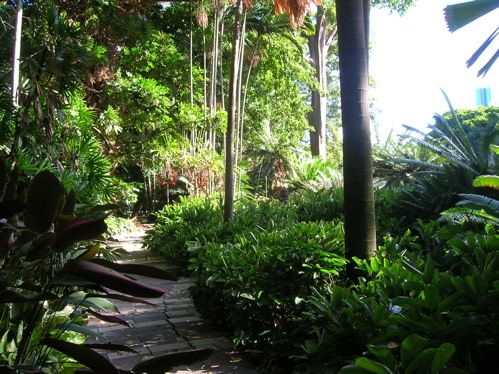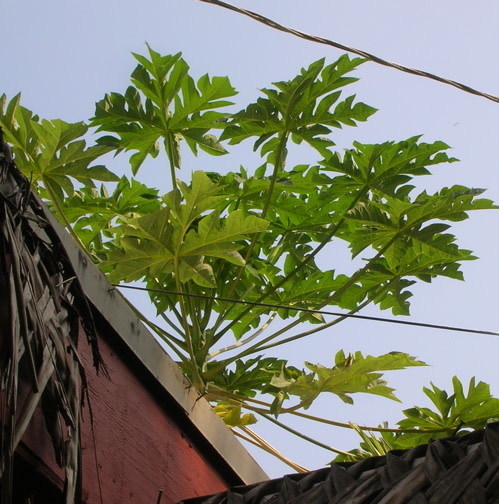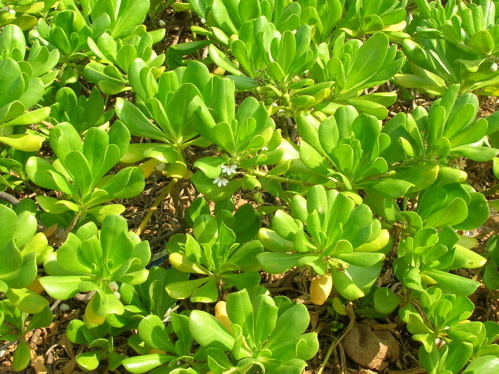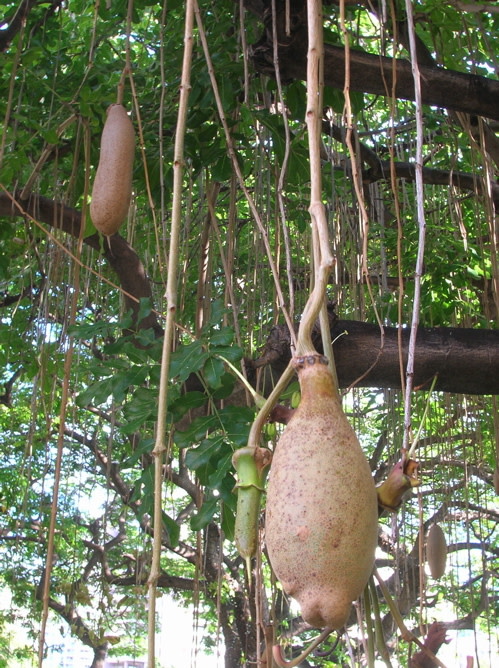Hardy plants for the tropicalesque garden

It isn’t that hard to create this kind of look in a temperate garden. Really.
Wandering the streets of Honolulu on Halloween, I can’t help but think about the idea of horticultural masquerade – how to dress up a temperate garden in tropical costume, as it were – to recreate the feeling of a tropical garden back home in Portland. There are a few different kinds of tropical plant masqueraders that work well for this purpose.

Is this papaya or is it rice paper plant (Tetrapanax)? It’s hard to tell without the context. Since this photo was taken in Hawai’i, it’s gotta be papaya, the Tetrapanax look-alike.
There are plenty of plants that resemble common tropical plants but are actually completely hardy. Of course I’ve already mentioned the Chinese paperbush – Edgeworthia. There’s also the rice paper plant – Tetrapanax papyfer – which resembles the tropical papaya. I did a double-take looking at a planting of pohinahina – Vitex rotundifolia – which looked for all the world like a low hebe hedge. There’s also a plant that resembles a dwarf form of hardy Pittosporum tobira. Known in Hawai’i as naupaka – Scaevola taccada – I found myself staring at it with disbelief when I first saw it from afar.

A Hawai’ian native plant called naupaka whose foliage resembles that of a landscape plant found in Portland (Pittosporum tobira), at least at first glance. Okay, maybe only after a fancy tropical drink or two…
Another category include plants that are common garden plants in the tropics but are also perfectly hardy in a temperate zone like Portland. These include Aucuba, mondo grass – Ophiopogon – and cast iron plant – Aspidistra.
And then there are those tropical masqueraders that have both hardy and tender members within the genus. I think of hibiscus, jasmine, oleander, ferns, palms, bananas, cannas, colocasia, and gingers, for starters. All of them have lush, tropical-looking family members that are cold-hardy yet look as lush as their tropical brethren.
Gingers are actually one of my favorite tropical masqueraders: Hedychium coccinium, H. coronarium, H. densiflorum, H. gardnerianum, and dozens of hybrids – to name just a few that grow well in Portland. The heady scent of H. coronarium definitely adds to the tropical feeling.
Cannas are fun but the flowers can be disagreeably bright and floppy. I like slender, narrow-leafed forms with darker leaves, like Canna ‘Intrigue’ – and I also like Canna musifolia, the banana-leafed canna (or the banana-canna, as it’s sometimes called). Reaching about 10 feet tall, it provides a wonderfully lush look and makes a big, lusty stand in just a couple of years.
Everyone knows you can grow banana trees in Oregon now – there are several hardy bananas but the most common is Musa basjoo. Easy as pie and capable of reaching 25 feet in height, this banana produces huge leaves and a truly tropical feeling in the garden. No, no edible fruit but who cares? You get those leaves!
Palms are a staple for any tropicalesque garden. There are plenty of hardy ones – the easiest to find being the Chinese windmill palm, Trachycarpus fortunei. These have been planted in Portland for years and some specimens reach 25 feet. But there are other species including other Trachycarpus species, dwarf palmetto – Sabal minor – and too many others to list. I suggest heading straight for Cistus Design Nursery for more information about hardy palms. (And, come to think of it, hardy gingers, bananas, cannas, jasmine, oleander, ferns, yuccas, agaves, and more.)
The tropical look is not the most fashionable trend in the gardening world right now. There was a hubbub over “Tropicalismo” about ten years ago and it seems to have fizzled out. But for some of us, it is beyond fashion: it’s an aesthetic that tugs at the heart. Love of tropicalesque plants can be born of anything from growing up or living in a tropical place to having oppositional-defiant disorder (you know, “everyone says you can’t grow things like that here but they’re all wrong!”) to just being, say, a deeply flamboyant personality. Whatever the reason, it’s good. If there’s an aesthetic you love and a type of plant that moves you, you had best embrace it. Gardening – or even simply spending time in a garden – is therapeutic. And if tropical-looking plants bring you good memories or make you feel happy, or fascinate you and draws you out into the garden, then that’s the way to go – fashionable or not. And if you’re lucky enough to live in a mid-century or ranch style house, you have even more reason to do it – tropicalesque plants look fantastic and are eminently well suited to such architectural styles.
My one admonition on the tropicennial-themed garden: large-leafed, tropical-looking plants are often thirsty plants that require summer water. After all, many of them come from lands of year-round rainfall – not summer-dry regions like ours. For this reason, plan ahead when creating a tropicalesque garden: enrich your soil with organic matter so it retains water and work on not mixing drought-tolerant, low-water plants with your moisture-loving tropicennials. That way, you conserve water by keeping it where it’s really needed.

I know of no hardy analogue for the “sausage tree”. This might be one of those tropical trees you don’t really want to try to replicate in a Portland garden. Except maybe for Halloween!
